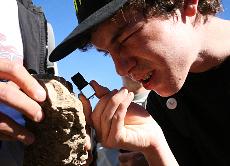At 9:35 on a warm October morning DVC instructor Jason Mayfield and four students place bets on whether a fifth student will show up wearing sandals.
Jessica Devries arrived minutes later – and she is in proper foot attire.
Every other Friday, Mayfield takes a hand-picked group of experienced geology students to Mt. Diablo, Briones and other regional parks in the Oakland/Berkeley hills to give them experience in field geology.
It’s a trial run for a class Mayfield wants to bring to the campus. The challenge, he says, is making sure there are enough students with enough basic knowledge in geology, to fill the classes.
On this day, the students map the geological makeup of a small area of Briones Regional Park near the Lafayette Ridge staging area, using colors to mark the different soil types on a topographical map.
Reminiscent of Indiana Jones, Mayfield wears a brimmed hat, carries a rock pick, and wears his Brunton compass and field notebook in leather holsters on either side of his belt.
“You remember how to tell the difference between silt and clay?” he asks. “You taste it.
“Whoo, it’s silty.”
“I can see some grains,” says Jim Ryan.
Students debate the type rock but Mayfield agreed with Ryan Schwingle’s assessment of “fine sand stone with silt lamination.”
It is determined this site was formed in “deep marine” because of the fine silt.
As the students walks to the second site, they pass the carcass of a deer eaten by coyotes or a mountain lion. A severed leg lies in the path.
The next site is determined to be “shallow” or “coastal marine” due to the shell fossils found in the rocks there.
“It’s just amazing,” says Marc Lichterman.” I enjoy hiking around anyway, this is great.”







































































